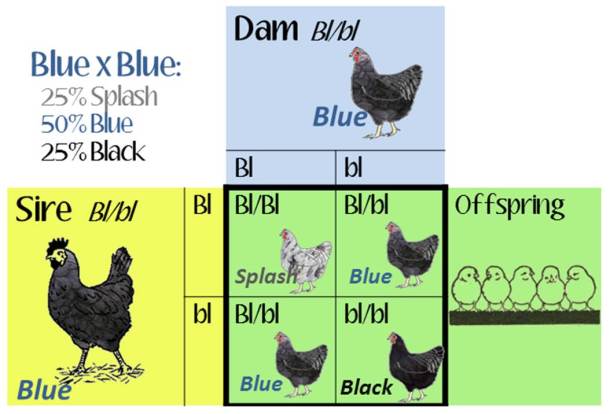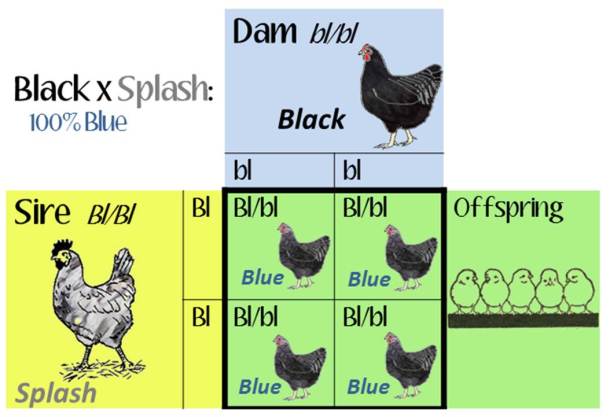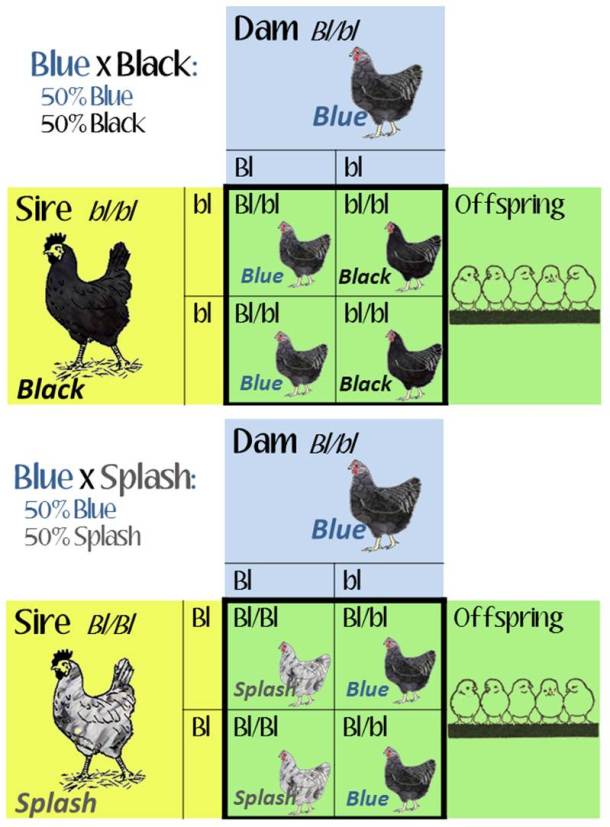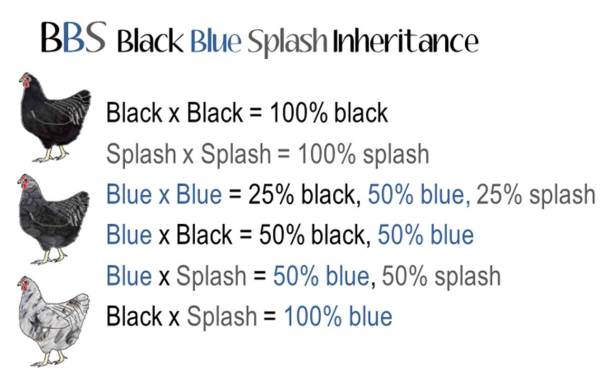Genetics of Plumage Part 1: Incomplete Dominance of Blue Feathering
Genetics Mini-Series Article #4
Dominant genes, represented by capitalized gene symbols, always assert themselves in simple dominance. If you have one gene for blue egg shells (O) and one gene for white egg shells (o), then there will be blue pigment in your eggs because the blue egg shell gene is dominant.
But not all genes work this way. Sometimes, the dominant form of a certain gene is not quite strong enough to completely hide the recessive form of the gene. If the gene is incompletely dominant, then having one dominant gene and one recessive gene results in a mix between the dominant and recessive traits. Remember, the genetic material we inherit is the genotype, and what we actually see – be it brown eyes or yellow shanks – is the phenotype. So, with genes that show incomplete dominance, a heterogeneous (mixed) genotype results in an intermediate phenotype.
A classic example is blue feathering in chickens. Blue is from a gene that inhibits black pigment, or eumelanin, in feathers. In the wild, fowl do not have this mutation, so their black pigment looks normal. Not having this pigment inhibitor is normal, or the wild type. In this case, wild type is recessive, so the symbol is bl+, with the “+” indicating that this is the wild type.
Bl is the gene symbol for the dominant trait where black pigment is inhibited or restricted. Now, here’s the incomplete dominance: Bl/Bl is splash. Bl/bl is blue. bl/bl is black. So, a lot of inhibiting results in mostly white feathers. Some inhibiting results in less-black feathers, and no inhibiting leaves black feathers alone. (Sometimes you see blue along with other colors, like red, on a chicken. This is because this inhibitor doesn’t dilute anything other than the black areas of the basic pattern.)
So, if you have two black chickens, they are both homogenous recessive bl/bl, there is no way you will get a blue or splash chicken from the cross. All of the offspring will also be black. By the same logic, if you have two splash chickens (Bl/Bl), there is no way you will get a black or blue chicken: All of the offspring will also be splash. However, when we cross two blue chickens (Bl/bl), we will see not only blue offspring, but also black and splash!That is great if you want a mixture of colors in the offspring. But what if you want to know that every chick that hatches will be blue? For that, you do not need blue parents. Instead, one parent should be black (bl/bl) and the other splash (Bl/Bl). All of the offspring will be blue! (Of course, if the blue offspring are bred back together, the full range of colors will appear again as in the chart above.)
Blue and black will result in half blue and half black offspring. Blue and splash will result in half blue and half splash offspring.
So, we have discussed incomplete dominance and seen that the blue gene in feathering demonstrates this pattern of inheritance because the heterogeneous genotype results in an intermediate level of pigment inhibition. Here’s a classic “black/blue/splash” or BBS chart to summarize the discussion above:
Shared with:
![By Julie Anne Workman (Own work) [CC-BY-SA-3.0 (http://creativecommons.org/licenses/by-sa/3.0)], via Wikimedia Commons](https://i0.wp.com/upload.wikimedia.org/wikipedia/commons/6/65/Blue_Cochin_hen.jpg)

![Wanny at nl.wikipedia [GFDL (http://www.gnu.org/copyleft/fdl.html), CC-BY-SA-3.0 (http://creativecommons.org/licenses/by-sa/3.0/) or CC-BY-SA-2.5 (http://creativecommons.org/licenses/by-sa/2.5)], from Wikimedia Commons](https://i0.wp.com/upload.wikimedia.org/wikipedia/commons/b/bf/Splash_Sumatra.jpg)







Your explanation of genetics is very clear. I think I am starting to understand it a little bit, I’m still not sure what I’m gonna get from a BCM roo over a GCM hen though. Any ideas?
Awesome! I’m glad to hear it. This chicken genetics calculator is a lot of fun to play around with: http://kippenjungle.nl/Overzicht.htm. If you select “black copper” for the sire and “golden cookoo” for the dam, you can see that all of the offspring would have a gold-based duckwing-ish pattern. But the cool thing is that your offspring would be sex-linked. I’ll explain it more in another post, but here’s a summary: Barring is a dominant sex-linked trait. Males inherit two genes – one from their dad and one from their mom. Females only have one gene for this trait, and it comes from their dad. If a female is barred, she will give that gene, the only one she has to give, to her sons. It’s dominant, so all of her sons will be barred. She can’t give this gene to her daughters; they can only get it from their father. If their father has no barring, like your BCM, then the pullets will all be un-barred. So, it’s sex-linked: All of your males will be barred and born with a white spot on their head, and all of the females will be unbarred and have no spot. Pretty cool. 🙂
Excellent again! And perfect content. I have been trying to figure out what to do with my Blue and Splash Orpingtons. If you say it’s OK, i’m going to post a link to this on the Orpington thread when someone asks again about how the blue coloring works.
Thanks! You’re certainly welcome to post a link anywhere you like. I’m trying to demystify the whole chicken-genetics thing at least as far as I understand it, so I hope it helps clear things up for folks. Thanks, NP!
Great post! I recently had a hatch of b/b/s Ameraucana. I understand a bit more about their possible parent stock. Very informative.
Pingback: The Fall Hatching Season has Arrived! « The Fruity Chicken
Wow! Thank you. I had flashbacks of college biology. You did a fantastic job on explaining everything. Thank you so much for linking up to the blog hop this week. I am so happy to have you with us. Have a wonderful weekend.~Melissa
Thank you, and you too!
Pingback: GMS Supplement #1: Recessive White « Scratch Cradle